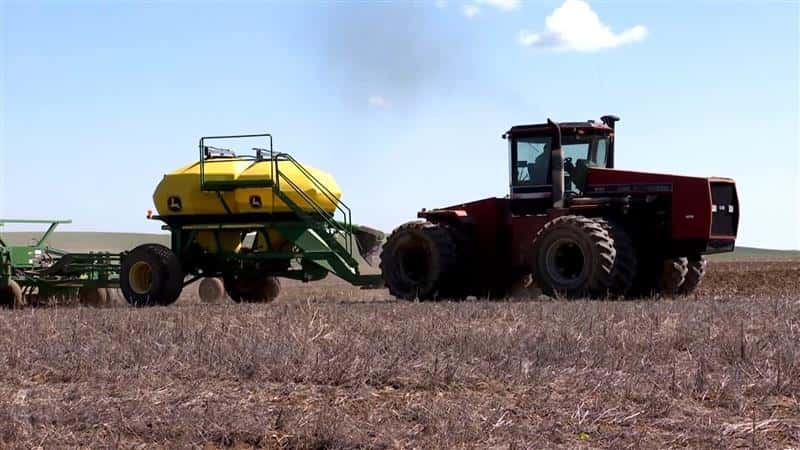Corn planting progress reached 81{665a3d7248b9690333c4195c142b942e2311c5bd36bcf4da0d19dbcb5cbdf347} complete nationwide as of Sunday, May 20, equal to the five-year average, according to the USDA National Ag Statistics Service weekly Crop Progress report released Monday.
Nationwide, corn planting progress jumped 19 percentage points last week, up from 62{665a3d7248b9690333c4195c142b942e2311c5bd36bcf4da0d19dbcb5cbdf347} the previous week. States showing the largest gaps behind their five-year averages were Pennsylvania, which was 29 points behind average; South Dakota, 15 points behind average; Michigan, 13 points behind average; Wisconsin, 10 points behind average; and Minnesota, 7 points behind average.
Corn emergence, at 50{665a3d7248b9690333c4195c142b942e2311c5bd36bcf4da0d19dbcb5cbdf347} nationwide as of Sunday, was slightly behind last year's 51{665a3d7248b9690333c4195c142b942e2311c5bd36bcf4da0d19dbcb5cbdf347} but ahead of the average pace of 47{665a3d7248b9690333c4195c142b942e2311c5bd36bcf4da0d19dbcb5cbdf347}.
Soybean planting remained ahead of average nationwide, except in the Northern states. Fifty-six percent of the crop was planted as of Sunday, according to NASS, 12 percentage points ahead of the average of 44{665a3d7248b9690333c4195c142b942e2311c5bd36bcf4da0d19dbcb5cbdf347}. Twenty-six percent of soybeans were emerged, ahead of 17{665a3d7248b9690333c4195c142b942e2311c5bd36bcf4da0d19dbcb5cbdf347} last year and also ahead of the average of 15{665a3d7248b9690333c4195c142b942e2311c5bd36bcf4da0d19dbcb5cbdf347}.
Winter wheat was 61{665a3d7248b9690333c4195c142b942e2311c5bd36bcf4da0d19dbcb5cbdf347} headed, behind last year's 71{665a3d7248b9690333c4195c142b942e2311c5bd36bcf4da0d19dbcb5cbdf347} and also behind the average of 64{665a3d7248b9690333c4195c142b942e2311c5bd36bcf4da0d19dbcb5cbdf347}. Winter wheat condition held steady last week at 36{665a3d7248b9690333c4195c142b942e2311c5bd36bcf4da0d19dbcb5cbdf347} good to excellent, still the crop's lowest rating since 2014-15. DTN's winter wheat condition rating of 58 points was also the lowest in four years.
Spring wheat was 79{665a3d7248b9690333c4195c142b942e2311c5bd36bcf4da0d19dbcb5cbdf347} planted as of Sunday, near the average pace of 80{665a3d7248b9690333c4195c142b942e2311c5bd36bcf4da0d19dbcb5cbdf347}. Thirty-seven percent of the crop was emerged, behind the five-year average of 52{665a3d7248b9690333c4195c142b942e2311c5bd36bcf4da0d19dbcb5cbdf347}.
Spring wheat planting was the furthest behind average in Montana, which, at 66{665a3d7248b9690333c4195c142b942e2311c5bd36bcf4da0d19dbcb5cbdf347} complete as of Sunday, was 20 points behind the five-year average of 86{665a3d7248b9690333c4195c142b942e2311c5bd36bcf4da0d19dbcb5cbdf347}. “I was around flooded areas of western Montana, but from the little I saw, I doubt the state will have trouble planting,” said DTN Analyst Todd Hultman. “Weather was in 60s and 70s and fields were green.”
Cotton was 52{665a3d7248b9690333c4195c142b942e2311c5bd36bcf4da0d19dbcb5cbdf347} planted as of Sunday, compared to 36{665a3d7248b9690333c4195c142b942e2311c5bd36bcf4da0d19dbcb5cbdf347} last week, 49{665a3d7248b9690333c4195c142b942e2311c5bd36bcf4da0d19dbcb5cbdf347} last year and 45{665a3d7248b9690333c4195c142b942e2311c5bd36bcf4da0d19dbcb5cbdf347} average. Rice was 93{665a3d7248b9690333c4195c142b942e2311c5bd36bcf4da0d19dbcb5cbdf347} planted, compared to 83{665a3d7248b9690333c4195c142b942e2311c5bd36bcf4da0d19dbcb5cbdf347} last week, 90{665a3d7248b9690333c4195c142b942e2311c5bd36bcf4da0d19dbcb5cbdf347} last year and 89{665a3d7248b9690333c4195c142b942e2311c5bd36bcf4da0d19dbcb5cbdf347} on average. Seventy-four percent of the crop was emerged, compared to 61{665a3d7248b9690333c4195c142b942e2311c5bd36bcf4da0d19dbcb5cbdf347} last week, 77{665a3d7248b9690333c4195c142b942e2311c5bd36bcf4da0d19dbcb5cbdf347} last year and a 74{665a3d7248b9690333c4195c142b942e2311c5bd36bcf4da0d19dbcb5cbdf347} average.
Sorghum was 39{665a3d7248b9690333c4195c142b942e2311c5bd36bcf4da0d19dbcb5cbdf347} planted as of Sunday, compared to 32{665a3d7248b9690333c4195c142b942e2311c5bd36bcf4da0d19dbcb5cbdf347} last week, 36{665a3d7248b9690333c4195c142b942e2311c5bd36bcf4da0d19dbcb5cbdf347} last year and a 38{665a3d7248b9690333c4195c142b942e2311c5bd36bcf4da0d19dbcb5cbdf347} average.
Barley was 81{665a3d7248b9690333c4195c142b942e2311c5bd36bcf4da0d19dbcb5cbdf347} planted, behind the average pace 84{665a3d7248b9690333c4195c142b942e2311c5bd36bcf4da0d19dbcb5cbdf347}. Forty-five percent of the crop was emerged as of Sunday, compared to an average of 58{665a3d7248b9690333c4195c142b942e2311c5bd36bcf4da0d19dbcb5cbdf347}. Oats were 86{665a3d7248b9690333c4195c142b942e2311c5bd36bcf4da0d19dbcb5cbdf347} planted, compared to 72{665a3d7248b9690333c4195c142b942e2311c5bd36bcf4da0d19dbcb5cbdf347} last week, 94{665a3d7248b9690333c4195c142b942e2311c5bd36bcf4da0d19dbcb5cbdf347} last year and a 91{665a3d7248b9690333c4195c142b942e2311c5bd36bcf4da0d19dbcb5cbdf347} average. Sixty-seven percent of oats were emerged, compared to 48{665a3d7248b9690333c4195c142b942e2311c5bd36bcf4da0d19dbcb5cbdf347} last week, 81{665a3d7248b9690333c4195c142b942e2311c5bd36bcf4da0d19dbcb5cbdf347} last year and a 77{665a3d7248b9690333c4195c142b942e2311c5bd36bcf4da0d19dbcb5cbdf347} average.
The following are highlights from weekly crop progress reports issued by National Ag Statistics Service offices in individual states. To view the full reports from each state, visit http://www.nass.usda.gov/…
Source: DTN


